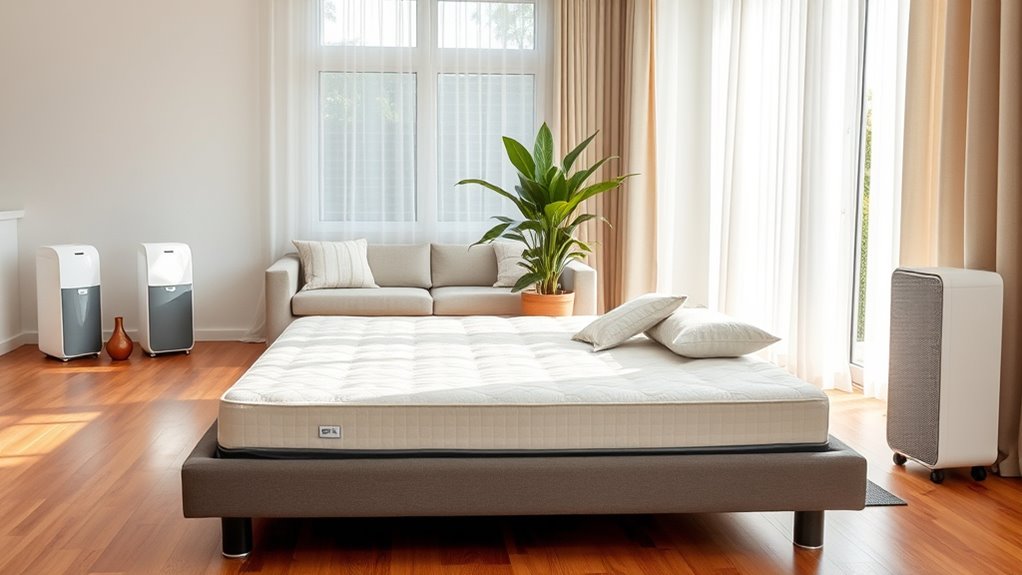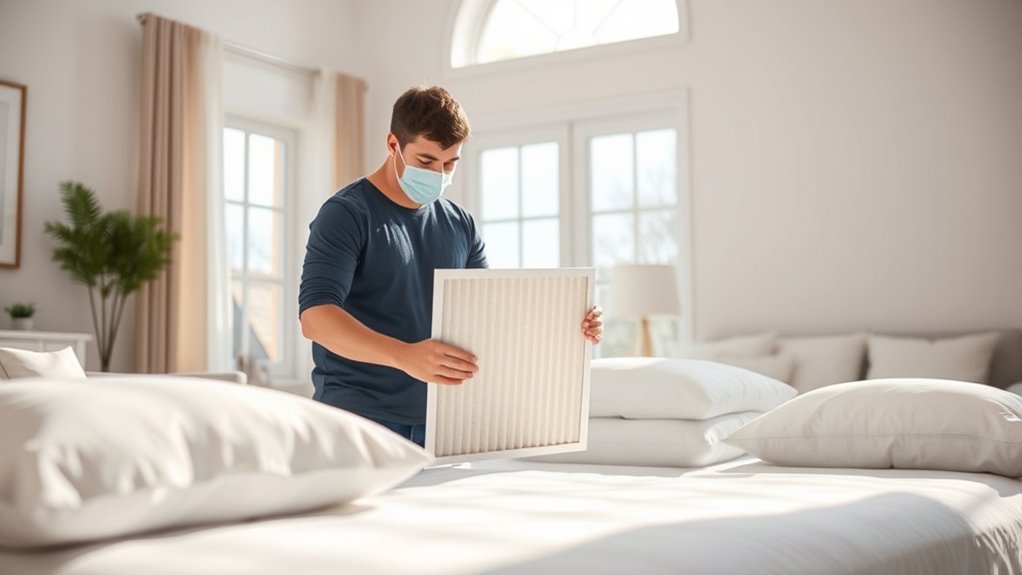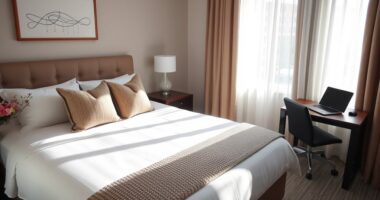To allergy-proof your home, use HEPA air purifiers in common areas and bedrooms to trap airborne allergens like dust, pollen, and pet dander. Keep humidity between 30-50% to prevent mold and dust mites, and wash bedding regularly in hot water. Vacuum with a HEPA filter and dust with a damp cloth to cut down on allergens. Maintaining good ventilation and managing pet dander also help. For more ways to breathe easier, discover how these strategies can work together effectively.
Key Takeaways
- Use HEPA air purifiers continuously in main living areas and bedrooms to remove airborne allergens effectively.
- Maintain indoor humidity levels between 30-50% to inhibit mold growth and dust mite proliferation.
- Regularly clean with HEPA-filtered vacuums and damp cloths to reduce dust, pet dander, and other allergens.
- Groom pets regularly and wash bedding and curtains in hot water to minimize allergen buildup.
- Incorporate allergen-friendly houseplants and ensure proper ventilation while monitoring outdoor pollen levels.

If you suffer from allergies, making your home allergy-proof can substantially improve your comfort and health. One of the most effective ways to do this is by investing in air purifier technology. Modern air purifiers are equipped with HEPA filters that trap tiny particles like pollen, dust mites, pet dander, and mold spores, preventing them from circulating in your indoor environment. Choose a unit specifically designed for allergy relief, and run it continuously in common areas and bedrooms. Regular maintenance, such as changing filters as recommended, ensures these devices perform at their best. Combining air purifier technology with good ventilation can significantly cut down your exposure to airborne allergens, making your living space safer and more comfortable. Additionally, understanding allergen sources can help target specific triggers and improve your overall allergy management.
Alongside mechanical solutions, exploring natural allergen remedies can help manage allergy symptoms. For example, keeping indoor humidity levels low—around 30-50%—reduces mold growth and dust mites. Using natural remedies like saline nasal rinses clears allergens from your nasal passages, providing quick relief without medications. Incorporating houseplants such as aloe vera or spider plants can improve air quality naturally, as some plants absorb airborne toxins. However, be cautious with plants that might shed pollen or mold; choose varieties that are less likely to trigger allergies. Regularly washing bedding and curtains in hot water also helps eliminate dust mites and pet dander, preventing allergen buildup.
Another natural approach involves cleaning routines. Use a vacuum equipped with a HEPA filter to pick up dust and allergens from carpets and upholstery. Avoid dry dusting or sweeping, which can stir up particles into the air. Instead, damp cloths trap dust better and reduce airborne allergens. If you have pets, grooming them regularly and keeping their bedding clean minimizes pet dander. Ensuring proper airflow by opening windows when outdoor air quality permits can also dilute indoor allergens, but this should be balanced with outdoor pollen levels during high seasons.
Incorporating these strategies creates a multi-layered defense against indoor allergens. Air purifier technology handles airborne particles, while natural allergen remedies reduce the presence and impact of common triggers. Maintaining a clean, well-ventilated environment, and choosing natural solutions tailored to your specific allergies, empowers you to create a healthier home. This proactive approach not only alleviates allergy symptoms but also enhances your overall well-being, allowing you to breathe easier and enjoy your space more fully.
Frequently Asked Questions
Can Allergy-Proofing Eliminate All Indoor Allergens?
You wonder if allergy-proofing can eliminate all indoor allergens. While strategies like dust mite prevention and mold control substantially reduce allergens, they can’t remove every single one. You should focus on minimizing exposure by cleaning regularly, using HEPA filters, and controlling humidity. These steps help, but some allergens may still linger, so managing symptoms and consulting a healthcare professional remain important for effective allergy relief.
Are Air Purifiers Necessary for Allergy-Proofing?
Imagine a Victorian parlor, where air was filtered through ornate devices—today, air purifiers are key for allergy-proofing. You’ll want to evaluate air purifier maintenance to guarantee it runs efficiently and check cost-effectiveness over time. While not always necessary, they can substantially reduce airborne allergens, especially if you suffer from allergies. Using them alongside other measures helps create a healthier environment, making your home more comfortable.
How Often Should I Clean My HVAC Filters?
You should clean your HVAC filters every 1 to 3 months to guarantee ideal HVAC maintenance and allergy prevention. Regularly changing or cleaning filters helps remove dust, pet dander, and other allergens from the air. If you have allergies or live with pets, consider checking filters more frequently, especially during peak allergy seasons. Proper filter maintenance keeps indoor air cleaner and reduces allergy symptoms effectively.
Do Certain Plants Worsen Indoor Allergies?
Certain plants can worsen indoor allergies because they may harbor indoor mold or attract pollen sources. You might notice increased allergy symptoms when these plants are present, especially if they’re overwatered or poorly ventilated. To reduce your allergy risk, choose hypoallergenic plants, keep them clean, and avoid those known for mold growth or pollen production. Proper plant care helps minimize indoor mold and pollen sources, making your home more comfortable.
Can Pet Allergies Be Completely Eliminated Indoors?
You might think pet allergies are unavoidable, but with the right steps, you can markedly reduce indoor pet dander. While completely eliminating pet allergies is tough, minimizing pet dander and indoor mold can help manage symptoms. Regular grooming, frequent cleaning, and using HEPA filters make a big difference. Though some allergens may persist, these actions can create a more comfortable living space, bringing relief and improving your quality of life.
Conclusion
By taking these allergy-proofing steps, you’re turning your home into a sanctuary where allergens can’t thrive. Think of it as planting seeds of health—each small change grows into a breathable, safer space for you and your loved ones. Remember, your home is your fortress; with vigilance and care, you can keep it shielded from allergens, allowing fresh air and comfort to flourish. After all, a healthier home is the foundation for a happier life.









